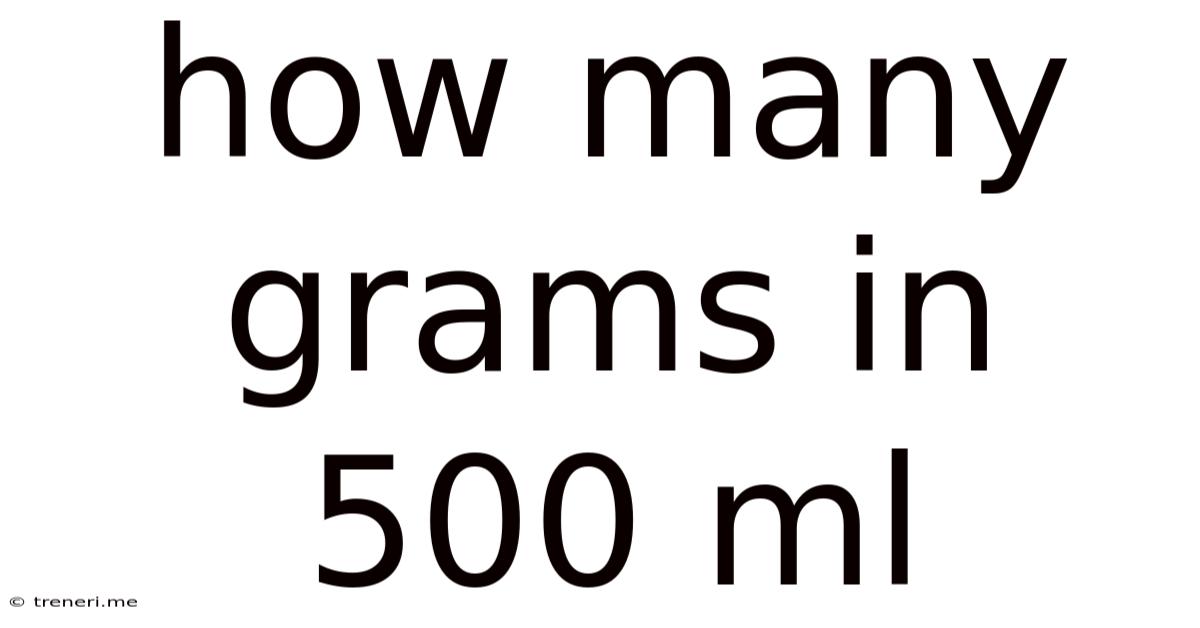How Many Grams In 500 Ml
Treneri
Apr 11, 2025 · 4 min read

Table of Contents
How Many Grams in 500ml? Understanding Volume and Mass
The question, "How many grams are in 500ml?" doesn't have a simple, single answer. It's a deceptively straightforward query that highlights a crucial concept in science and everyday life: the difference between volume (measured in milliliters, ml) and mass (measured in grams, g). While seemingly related, they are distinct properties of matter. To understand the relationship, we need to consider density.
Understanding Density: The Key to the Conversion
Density is the mass of a substance per unit volume. It's essentially how much "stuff" is packed into a given space. The formula for density is:
Density (ρ) = Mass (m) / Volume (V)
This means that to determine the mass (in grams) of 500ml of a substance, we need to know its density. Different substances have different densities. For example:
- Water: At 4°C (its point of maximum density), the density of water is approximately 1 g/ml. This makes it a convenient reference point.
- Oil: Oils typically have densities less than 1 g/ml, meaning they are less dense than water and will float on it.
- Mercury: Mercury is much denser than water, with a density significantly greater than 1 g/ml.
- Metals: Metals like gold, lead, and iron have very high densities, meaning a small volume contains a significant mass.
Therefore, the number of grams in 500ml depends entirely on the density of the substance.
Calculating Mass for Different Substances: Examples
Let's illustrate this with some examples:
Example 1: Water
For water at 4°C, with a density of approximately 1 g/ml:
Mass (m) = Density (ρ) × Volume (V) Mass (m) = 1 g/ml × 500 ml Mass (m) = 500 g
Therefore, 500ml of water at 4°C weighs approximately 500 grams.
It's important to note that the density of water changes slightly with temperature. At room temperature (around 20°C), the density is slightly less than 1 g/ml, resulting in a slightly lower mass for 500ml. However, the difference is negligible for most practical purposes.
Example 2: Vegetable Oil
Let's assume the density of a particular vegetable oil is 0.92 g/ml. Then:
Mass (m) = Density (ρ) × Volume (V) Mass (m) = 0.92 g/ml × 500 ml Mass (m) = 460 g
Therefore, 500ml of this vegetable oil weighs approximately 460 grams.
Example 3: Mercury
If the density of mercury is 13.6 g/ml:
Mass (m) = Density (ρ) × Volume (V) Mass (m) = 13.6 g/ml × 500 ml Mass (m) = 6800 g or 6.8 kg
Therefore, 500ml of mercury weighs a significant 6800 grams (6.8 kilograms).
These examples clearly demonstrate how crucial density is in determining the mass of a given volume. Without knowing the density of the substance, we cannot accurately calculate its mass.
Factors Affecting Density
Several factors can influence the density of a substance:
- Temperature: As temperature increases, the volume of a substance usually increases (due to thermal expansion), while the mass remains relatively constant. This leads to a decrease in density.
- Pressure: Increased pressure generally leads to a decrease in volume, resulting in an increase in density.
- Composition: The composition of a mixture or solution significantly affects its overall density. For instance, adding salt to water increases the density of the solution.
- Phase: A substance's phase (solid, liquid, or gas) dramatically impacts its density. Solids are generally denser than liquids, and liquids are denser than gases.
Beyond Simple Conversions: Real-World Applications
Understanding the relationship between volume, mass, and density has numerous practical applications:
- Chemistry: Density is frequently used in chemical analyses and calculations to determine concentrations and identify substances.
- Physics: Density is a critical parameter in many physics principles, such as buoyancy and fluid dynamics.
- Engineering: Engineers use density calculations in various applications, including structural design and fluid flow management.
- Everyday Life: We implicitly use density concepts daily, even without realizing it. For example, when we notice that a substance floats or sinks in water, we're observing the relative densities of the substances involved.
Practical Considerations and Further Exploration
While the formula Mass = Density x Volume is straightforward, obtaining accurate density values can be challenging. Density values often vary slightly depending on the source and measurement conditions. For precise calculations, it's crucial to use the most accurate density value available for the specific substance and conditions under consideration.
Furthermore, exploring the concept of specific gravity can be helpful. Specific gravity is the ratio of the density of a substance to the density of a reference substance (usually water). This dimensionless quantity provides a convenient way to compare the relative densities of different substances.
In conclusion, there's no single answer to "How many grams are in 500ml?". The mass depends entirely on the density of the substance in question. By understanding the concept of density and applying the appropriate formula, we can accurately determine the mass of 500ml of any given substance. This seemingly simple conversion highlights the fundamental difference between volume and mass and underscores the importance of considering density in various scientific and everyday contexts. Remember to always consult reliable sources for accurate density values when performing these calculations.
Latest Posts
Latest Posts
-
How Long To Burn Uv 6
May 09, 2025
-
How Many Days Is 62000 Minutes
May 09, 2025
-
Cuanto Es Grados Centigrados A Farenheit
May 09, 2025
-
1 2 5 As An Improper Fraction
May 09, 2025
-
Lowest Common Denominator Of 5 And 7
May 09, 2025
Related Post
Thank you for visiting our website which covers about How Many Grams In 500 Ml . We hope the information provided has been useful to you. Feel free to contact us if you have any questions or need further assistance. See you next time and don't miss to bookmark.